Abstract
Results concerning the ruminal fluid growth requirement of the ruminal acetogen, Syntrophococcus sucromutans, indicate that octadecenoic acid isomers satisfy this essential requirement. Complex lipids, such as triglycerides and phospholipids, can also support growth. The cellular fatty acid and aldehyde composition closely reflects that of the lipid supplement provided to the cells. Up to 98% of the fatty acids and 80% of the fatty aldehydes are identical in chain length and degree of unsaturation to the octadecenoic acid supplement provided in the medium. S. sucromutans shows a tendency to have a greater proportion of the aldehyde form among its 18 carbon chains than it does with the shorter-chain simple lipids, which may be interpreted as a strategy to maintain membrane fluidity. 14C labeling showed that most of the oleic acid taken up from the medium was incorporated into the membrane fraction of the cells.
Full text
PDF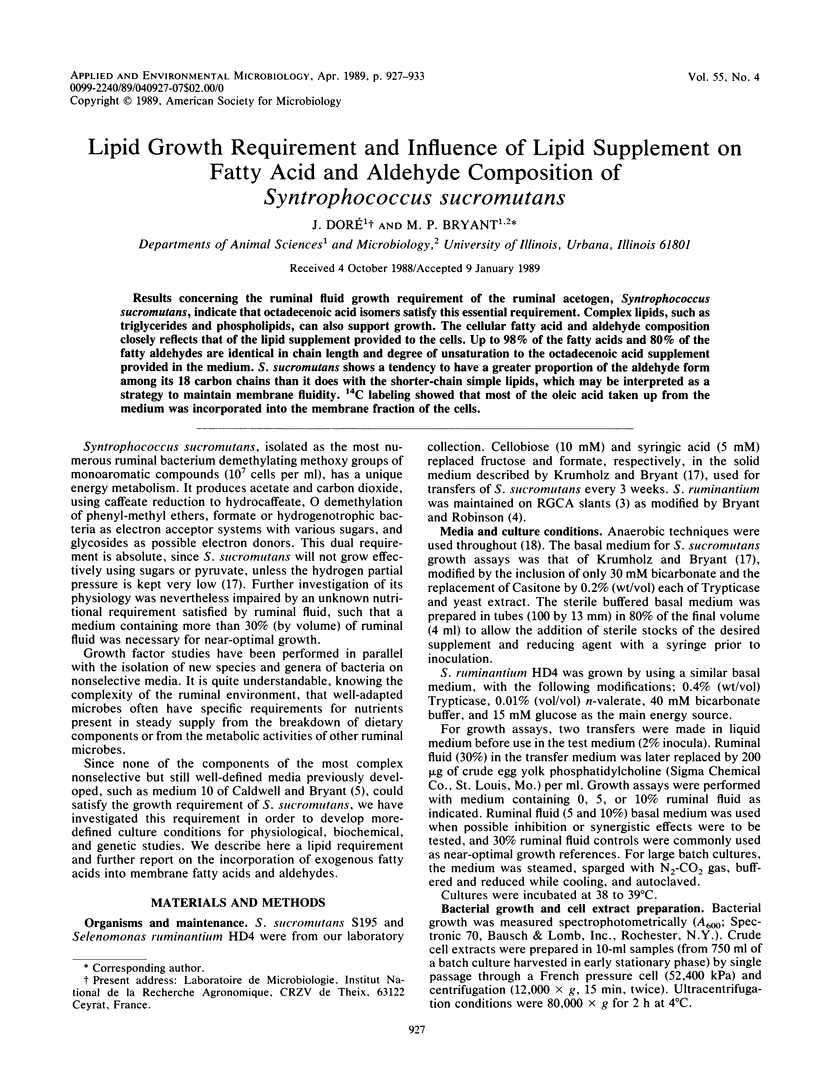
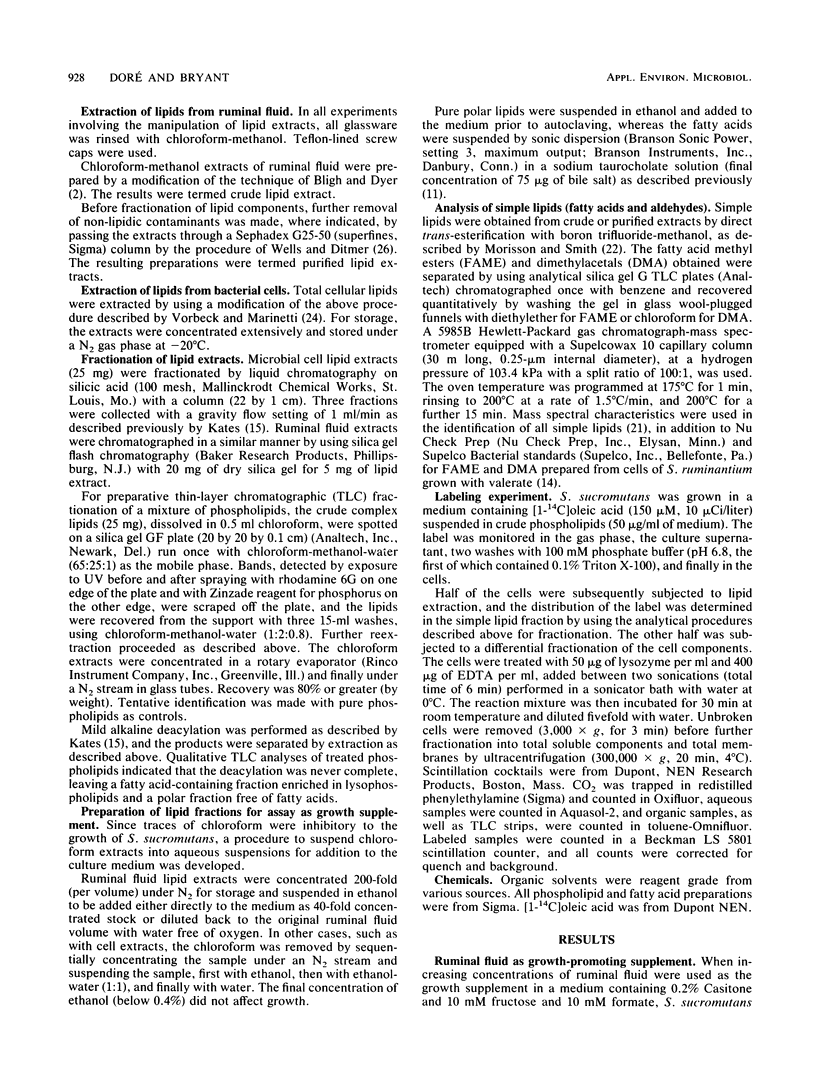
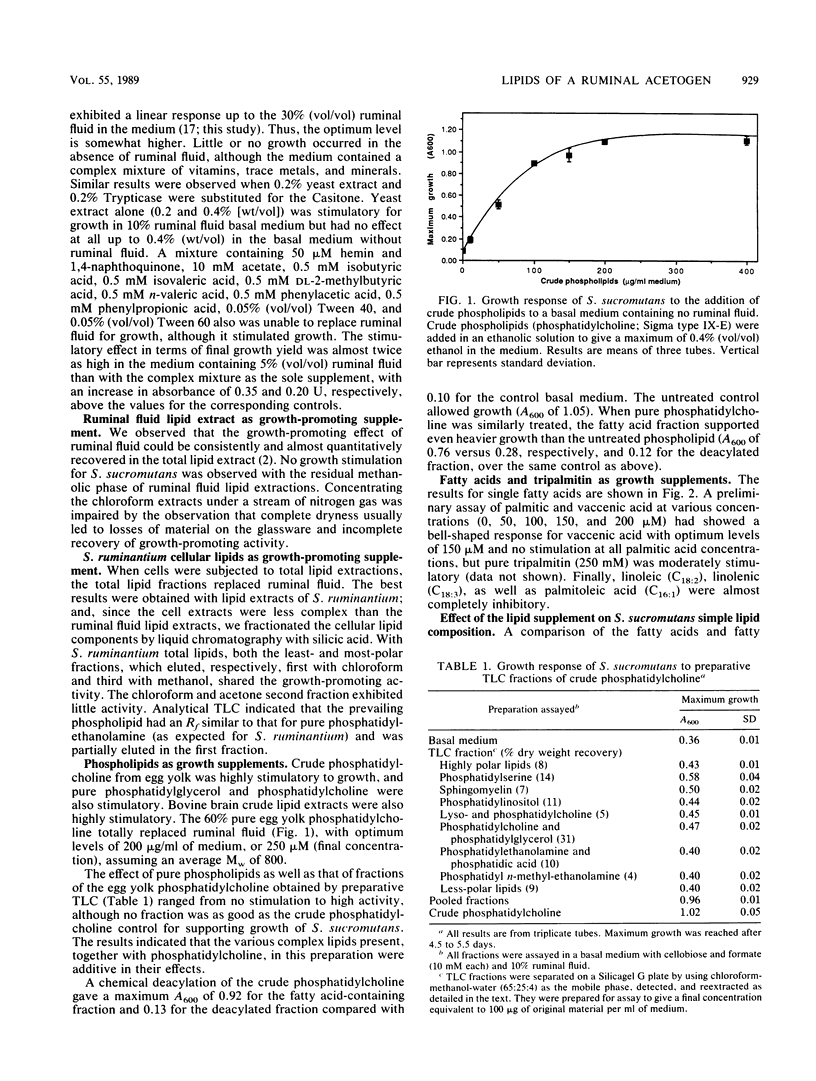
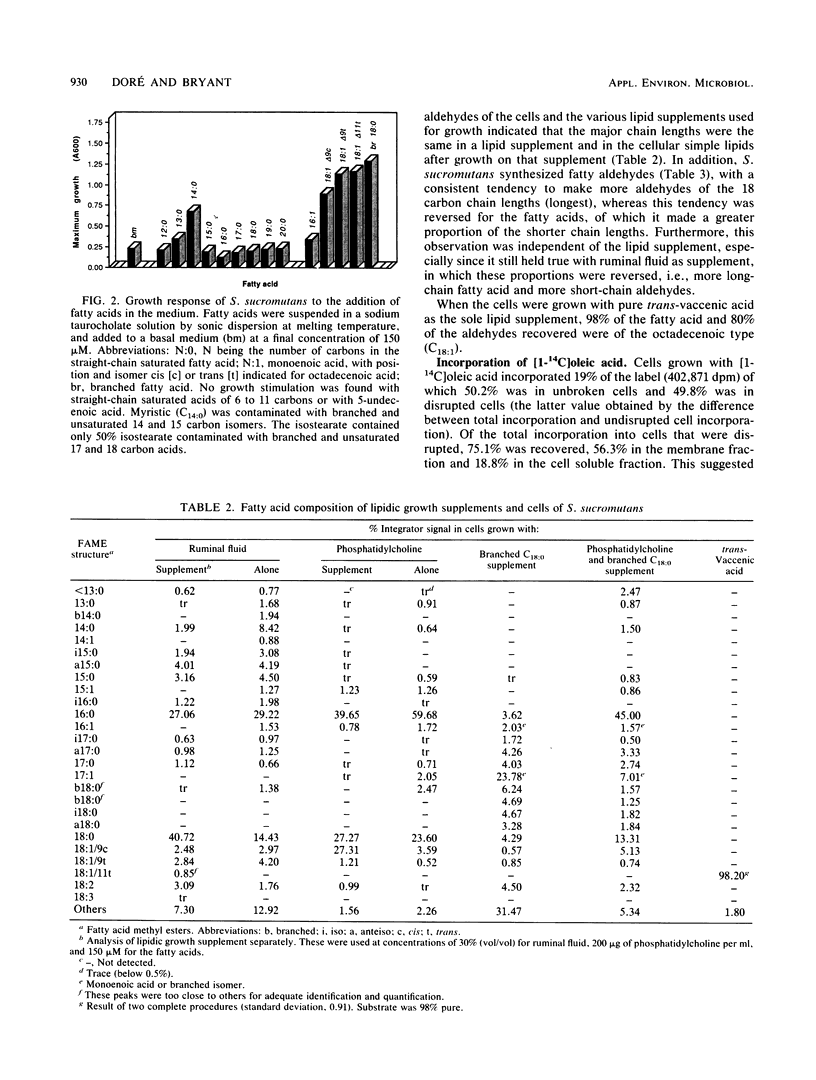
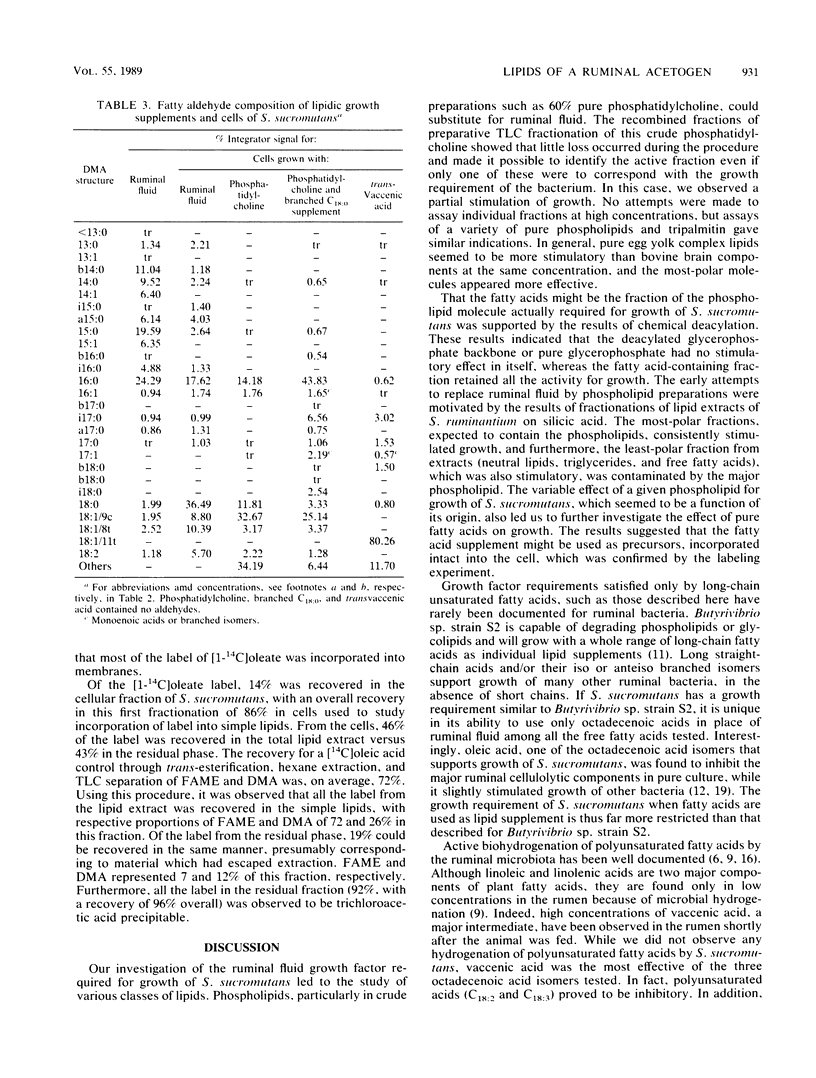
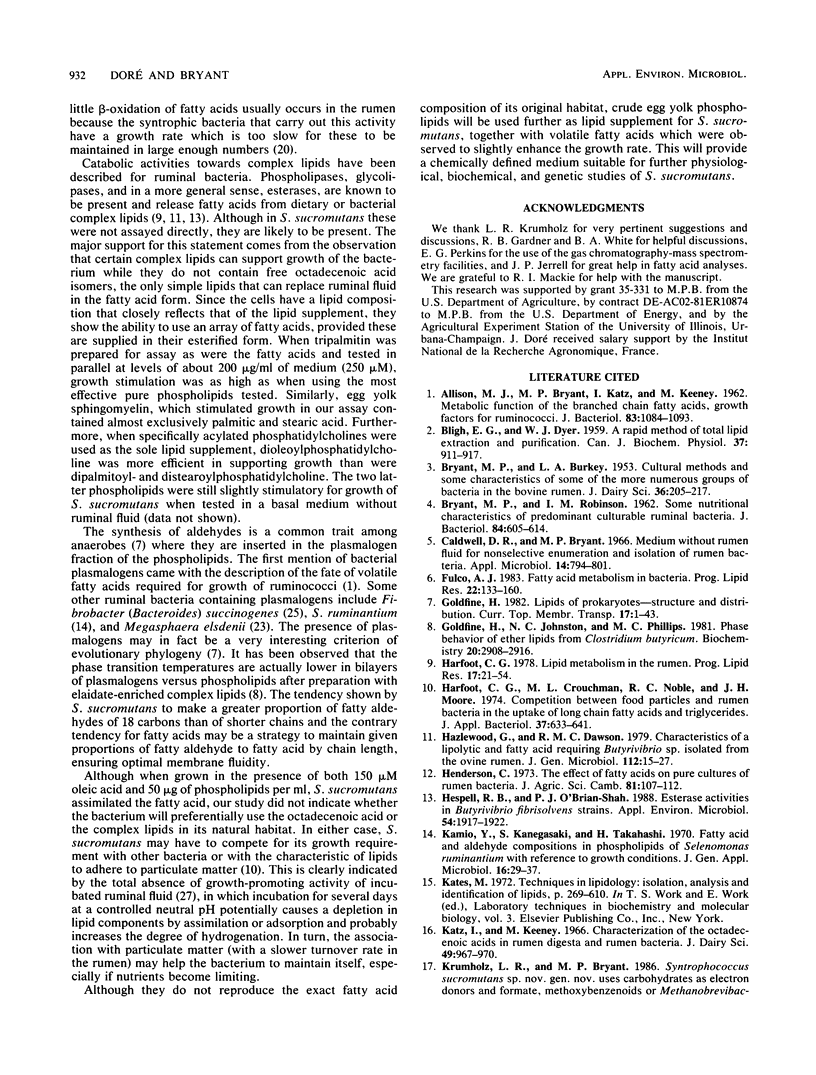
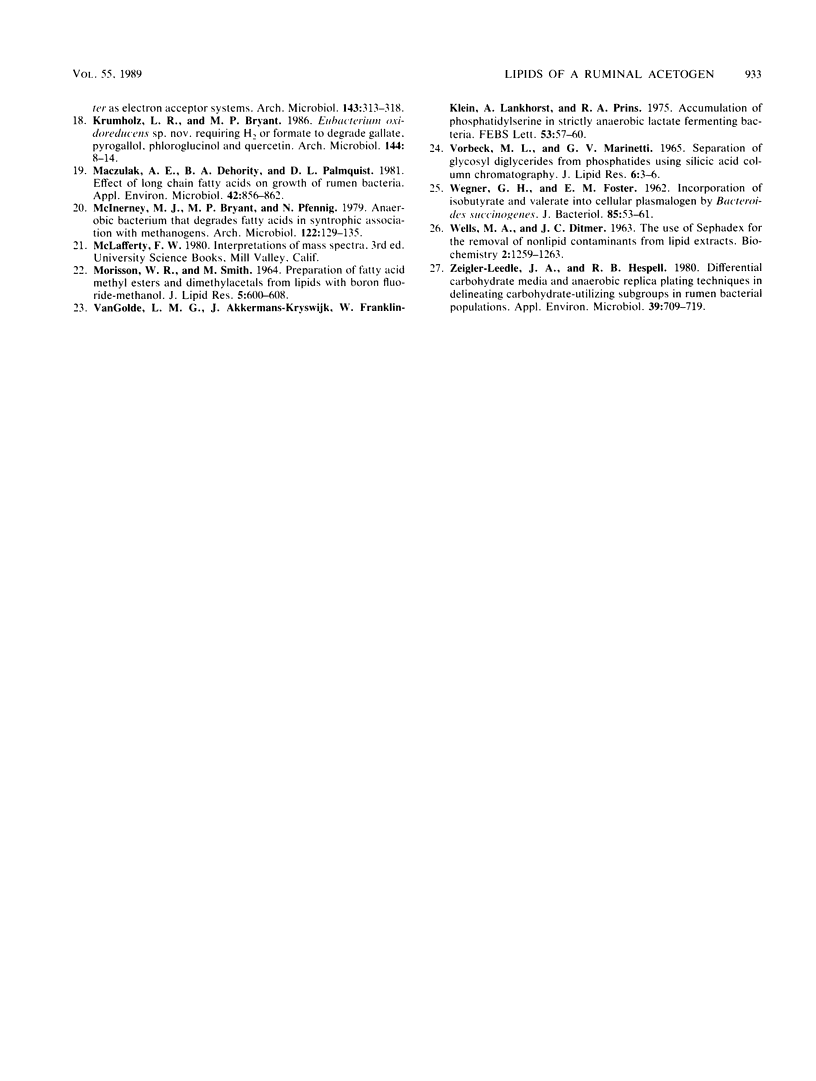
Selected References
These references are in PubMed. This may not be the complete list of references from this article.
- ALLISON M. J., BRYANT M. P., KATZ I., KEENEY M. Metabolic function of branched-chain volatile fatty acids, growth factors for ruminococci. II. Biosynthesis of higher branched-chain fatty acids and aldehydes. J Bacteriol. 1962 May;83:1084–1093. doi: 10.1128/jb.83.5.1084-1093.1962. [DOI] [PMC free article] [PubMed] [Google Scholar]
- BLIGH E. G., DYER W. J. A rapid method of total lipid extraction and purification. Can J Biochem Physiol. 1959 Aug;37(8):911–917. doi: 10.1139/o59-099. [DOI] [PubMed] [Google Scholar]
- BRYANT M. P., ROBINSON I. M. Some nutritional characteristics of predominant culturable ruminal bacteria. J Bacteriol. 1962 Oct;84:605–614. doi: 10.1128/jb.84.4.605-614.1962. [DOI] [PMC free article] [PubMed] [Google Scholar]
- Caldwell D. R., Bryant M. P. Medium without rumen fluid for nonselective enumeration and isolation of rumen bacteria. Appl Microbiol. 1966 Sep;14(5):794–801. doi: 10.1128/am.14.5.794-801.1966. [DOI] [PMC free article] [PubMed] [Google Scholar]
- Fulco A. J. Fatty acid metabolism in bacteria. Prog Lipid Res. 1983;22(2):133–160. doi: 10.1016/0163-7827(83)90005-x. [DOI] [PubMed] [Google Scholar]
- Goldfine H., Johnston N. C., Phillips M. C. Phase behavior of ether lipids from Clostridium butyricum. Biochemistry. 1981 May 12;20(10):2908–2916. doi: 10.1021/bi00513a030. [DOI] [PubMed] [Google Scholar]
- Harfoot C. G., Crouchman M. L., Noble R. C., Moore J. H. Competition between food particles and rumen bacteria in the uptake of long-chain fatty acids and triglycerides. J Appl Bacteriol. 1974 Dec;37(4):633–641. doi: 10.1111/j.1365-2672.1974.tb00487.x. [DOI] [PubMed] [Google Scholar]
- Harfoot C. G. Lipid metabolism in the rumen. Prog Lipid Res. 1978;17(1):21–54. doi: 10.1016/0079-6832(78)90004-6. [DOI] [PubMed] [Google Scholar]
- Hazlewood G., Dawson R. M. Characteristics of a lipolytic and fatty acid-requiring Butyrivibrio sp. isolated from the ovine rumen. J Gen Microbiol. 1979 May;112(1):15–27. doi: 10.1099/00221287-112-1-15. [DOI] [PubMed] [Google Scholar]
- Hespell R. B., O'Bryan-Shah P. J. Esterase activities in Butyrivibrio fibrisolvens strains. Appl Environ Microbiol. 1988 Aug;54(8):1917–1922. doi: 10.1128/aem.54.8.1917-1922.1988. [DOI] [PMC free article] [PubMed] [Google Scholar]
- Katz I., Keeney M. Occurrence of ketostearic acids in the rumen. J Dairy Sci. 1966 Aug;49(8):967–970. doi: 10.3168/jds.S0022-0302(66)87991-2. [DOI] [PubMed] [Google Scholar]
- Leedle J. A., Hespell R. B. Differential carbohydrate media and anaerobic replica plating techniques in delineating carbohydrate-utilizing subgroups in rumen bacterial populations. Appl Environ Microbiol. 1980 Apr;39(4):709–719. doi: 10.1128/aem.39.4.709-719.1980. [DOI] [PMC free article] [PubMed] [Google Scholar]
- MORRISON W. R., SMITH L. M. PREPARATION OF FATTY ACID METHYL ESTERS AND DIMETHYLACETALS FROM LIPIDS WITH BORON FLUORIDE--METHANOL. J Lipid Res. 1964 Oct;5:600–608. [PubMed] [Google Scholar]
- Maczulak A. E., Dehority B. A., Palmquist D. L. Effects of long-chain Fatty acids on growth of rumen bacteria. Appl Environ Microbiol. 1981 Nov;42(5):856–862. doi: 10.1128/aem.42.5.856-862.1981. [DOI] [PMC free article] [PubMed] [Google Scholar]
- VORBECK M. L., MARINETTI G. V. SEPARATION OF GLYCOSYL DIGLYCERIDES FROM PHOSPHATIDES USING SILICIC ACID COLUMN CHROMATOGRAPHY. J Lipid Res. 1965 Jan;6:3–6. [PubMed] [Google Scholar]
- Van Golde L. M., Akkermans-Kruyswijk J., Franklin-Klein W., Lankhorst A., Prins R. A. Accumulation of phosphatidylserine in strictly anaerobic lactate fermenting bacteria. FEBS Lett. 1975 Apr 15;53(1):57–60. doi: 10.1016/0014-5793(75)80681-8. [DOI] [PubMed] [Google Scholar]
- WEGNER G. H., FOSTER E. M. Incorporation of isobutyrate and valerate into cellular plasmalogen by Bacteroides succinogenes. J Bacteriol. 1963 Jan;85:53–61. doi: 10.1128/jb.85.1.53-61.1963. [DOI] [PMC free article] [PubMed] [Google Scholar]
- WELLS M. A., DITTMER J. C. THE USE OF SEPHADEX FOR THE REMOVAL OF NONLIPID CONTAMINANTS FROM LIPID EXTRACTS. Biochemistry. 1963 Nov-Dec;2:1259–1263. doi: 10.1021/bi00906a015. [DOI] [PubMed] [Google Scholar]


